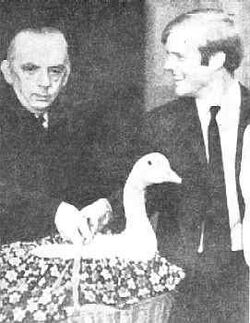Approximation property

In mathematics, specifically functional analysis, a Banach space is said to have the approximation property (AP), if every compact operator is a limit of finite-rank operators. The converse is always true.
Every Hilbert space has this property. There are, however, Banach spaces which do not; Per Enflo published the first counterexample in a 1973 article. However, much work in this area was done by Grothendieck (1955).
Later many other counterexamples were found. The space of bounded operators on [math]\displaystyle{ \ell^2 }[/math] does not have the approximation property.[2] The spaces [math]\displaystyle{ \ell^p }[/math] for [math]\displaystyle{ p\neq 2 }[/math] and [math]\displaystyle{ c_0 }[/math] (see Sequence space) have closed subspaces that do not have the approximation property.
Definition
A locally convex topological vector space X is said to have the approximation property, if the identity map can be approximated, uniformly on precompact sets, by continuous linear maps of finite rank.[3]
For a locally convex space X, the following are equivalent:[3]
- X has the approximation property;
- the closure of [math]\displaystyle{ X^{\prime} \otimes X }[/math] in [math]\displaystyle{ \operatorname{L}_p(X, X) }[/math] contains the identity map [math]\displaystyle{ \operatorname{Id} : X \to X }[/math];
- [math]\displaystyle{ X^{\prime} \otimes X }[/math] is dense in [math]\displaystyle{ \operatorname{L}_p(X, X) }[/math];
- for every locally convex space Y, [math]\displaystyle{ X^{\prime} \otimes Y }[/math] is dense in [math]\displaystyle{ \operatorname{L}_p(X, Y) }[/math];
- for every locally convex space Y, [math]\displaystyle{ Y^{\prime} \otimes X }[/math] is dense in [math]\displaystyle{ \operatorname{L}_p(Y, X) }[/math];
where [math]\displaystyle{ \operatorname{L}_p(X, Y) }[/math] denotes the space of continuous linear operators from X to Y endowed with the topology of uniform convergence on pre-compact subsets of X.
If X is a Banach space this requirement becomes that for every compact set [math]\displaystyle{ K\subset X }[/math] and every [math]\displaystyle{ \varepsilon\gt 0 }[/math], there is an operator [math]\displaystyle{ T\colon X\to X }[/math] of finite rank so that [math]\displaystyle{ \|Tx-x\|\leq\varepsilon }[/math], for every [math]\displaystyle{ x \in K }[/math].
Related definitions
Some other flavours of the AP are studied:
Let [math]\displaystyle{ X }[/math] be a Banach space and let [math]\displaystyle{ 1\leq\lambda\lt \infty }[/math]. We say that X has the [math]\displaystyle{ \lambda }[/math]-approximation property ([math]\displaystyle{ \lambda }[/math]-AP), if, for every compact set [math]\displaystyle{ K\subset X }[/math] and every [math]\displaystyle{ \varepsilon\gt 0 }[/math], there is an operator [math]\displaystyle{ T\colon X \to X }[/math] of finite rank so that [math]\displaystyle{ \|Tx - x\|\leq\varepsilon }[/math], for every [math]\displaystyle{ x \in K }[/math], and [math]\displaystyle{ \|T\|\leq\lambda }[/math].
A Banach space is said to have bounded approximation property (BAP), if it has the [math]\displaystyle{ \lambda }[/math]-AP for some [math]\displaystyle{ \lambda }[/math].
A Banach space is said to have metric approximation property (MAP), if it is 1-AP.
A Banach space is said to have compact approximation property (CAP), if in the definition of AP an operator of finite rank is replaced with a compact operator.
Examples
- Every subspace of an arbitrary product of Hilbert spaces possesses the approximation property.[3] In particular,
- every Hilbert space has the approximation property.
- every projective limit of Hilbert spaces, as well as any subspace of such a projective limit, possesses the approximation property.[3]
- every nuclear space possesses the approximation property.
- Every separable Frechet space that contains a Schauder basis possesses the approximation property.[3]
- Every space with a Schauder basis has the AP (we can use the projections associated to the base as the [math]\displaystyle{ T }[/math]'s in the definition), thus many spaces with the AP can be found. For example, the [math]\displaystyle{ \ell^p }[/math] spaces, or the symmetric Tsirelson space.
References
- ↑ Megginson, Robert E. An Introduction to Banach Space Theory p. 336
- ↑ Szankowski, A.: B(H) does not have the approximation property. Acta Math. 147, 89-108(1981).
- ↑ Jump up to: 3.0 3.1 3.2 3.3 3.4 Schaefer & Wolff 1999, p. 108-115.
Bibliography
- Bartle, R. G. (1977). "MR0402468 (53 #6288) (Review of Per Enflo's "A counterexample to the approximation problem in Banach spaces" Acta Mathematica 130 (1973), 309–317)". Mathematical Reviews.
- Enflo, P.: A counterexample to the approximation property in Banach spaces. Acta Math. 130, 309–317(1973).
- Grothendieck, A.: Produits tensoriels topologiques et espaces nucleaires. Memo. Amer. Math. Soc. 16 (1955).
- Halmos, Paul R. (1978). "Schauder bases". American Mathematical Monthly 85 (4): 256–257. doi:10.2307/2321165.
- Paul R. Halmos, "Has progress in mathematics slowed down?" Amer. Math. Monthly 97 (1990), no. 7, 561—588. MR1066321
- William B. Johnson "Complementably universal separable Banach spaces" in Robert G. Bartle (ed.), 1980 Studies in functional analysis, Mathematical Association of America.
- Kwapień, S. "On Enflo's example of a Banach space without the approximation property". Séminaire Goulaouic–Schwartz 1972—1973: Équations aux dérivées partielles et analyse fonctionnelle, Exp. No. 8, 9 pp. Centre de Math., École Polytech., Paris, 1973. MR407569
- Lindenstrauss, J.; Tzafriri, L.: Classical Banach Spaces I, Sequence spaces, 1977.
- Nedevski, P.; Trojanski, S. (1973). "P. Enflo solved in the negative Banach's problem on the existence of a basis for every separable Banach space". Fiz.-Mat. Spis. Bulgar. Akad. Nauk. 16 (49): 134–138.
- Pietsch, Albrecht (2007). History of Banach spaces and linear operators. Boston, MA: Birkhäuser Boston, Inc.. pp. xxiv+855 pp.. ISBN 978-0-8176-4367-6. https://books.google.com/books?id=MMorKHumdZAC&pg=PA203&dq=Pietsch.
- Karen Saxe, Beginning Functional Analysis, Undergraduate Texts in Mathematics, 2002 Springer-Verlag, New York.
- Schaefer, Helmut H.; Wolff, M.P. (1999). Topological Vector Spaces. GTM. 3. New York: Springer-Verlag. ISBN 9780387987262.
- Singer, Ivan. Bases in Banach spaces. II. Editura Academiei Republicii Socialiste România, Bucharest; Springer-Verlag, Berlin-New York, 1981. viii+880 pp. ISBN:3-540-10394-5. MR610799
 |

